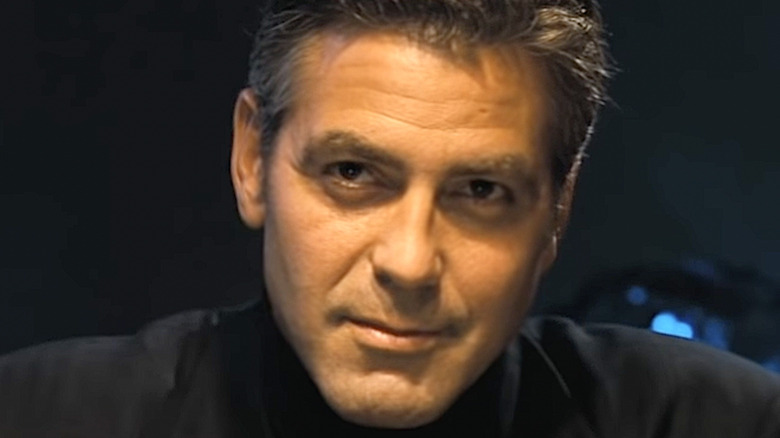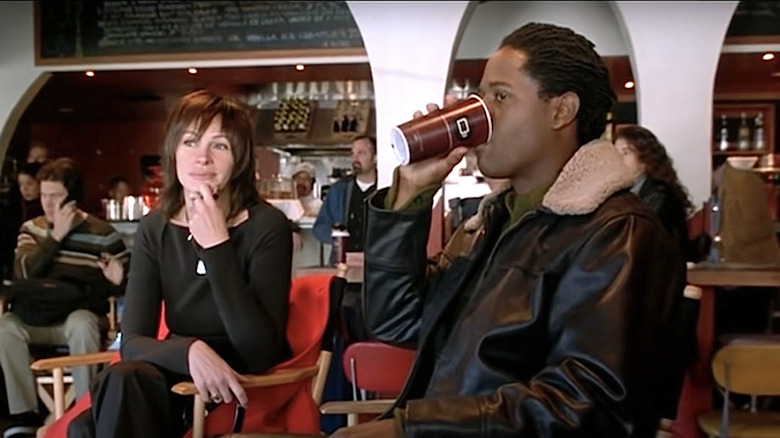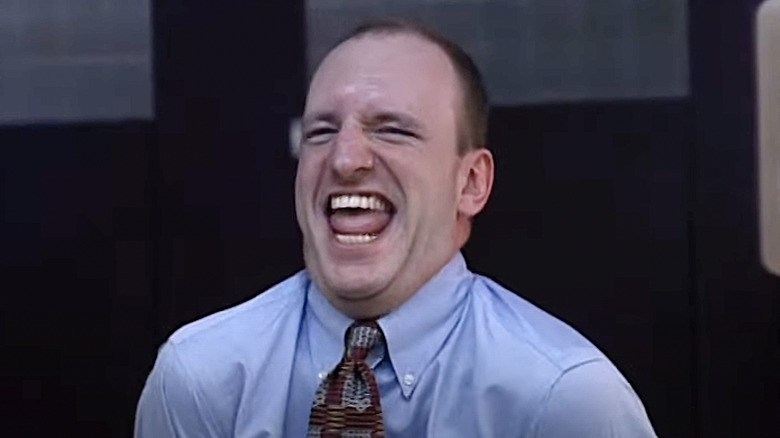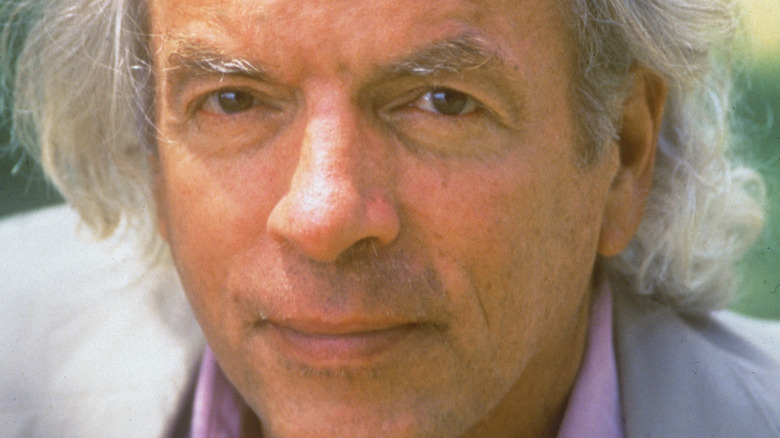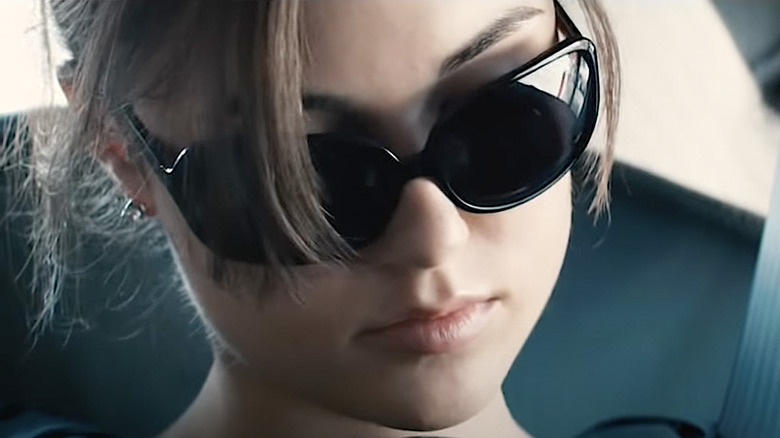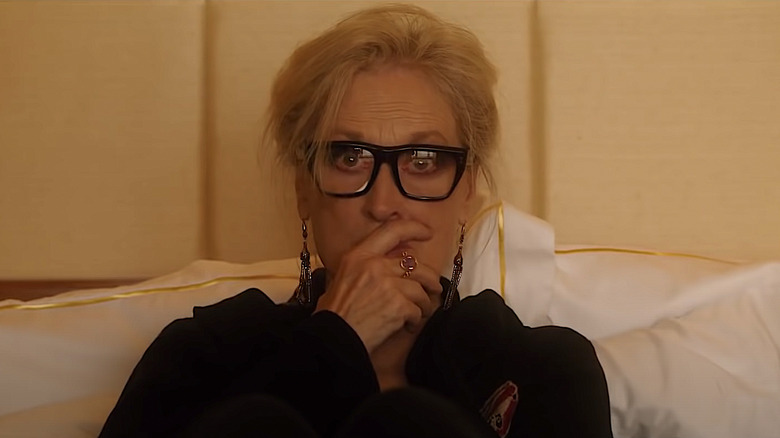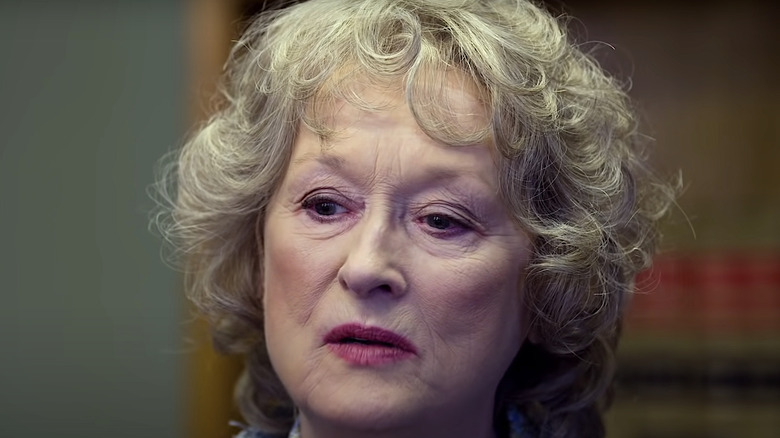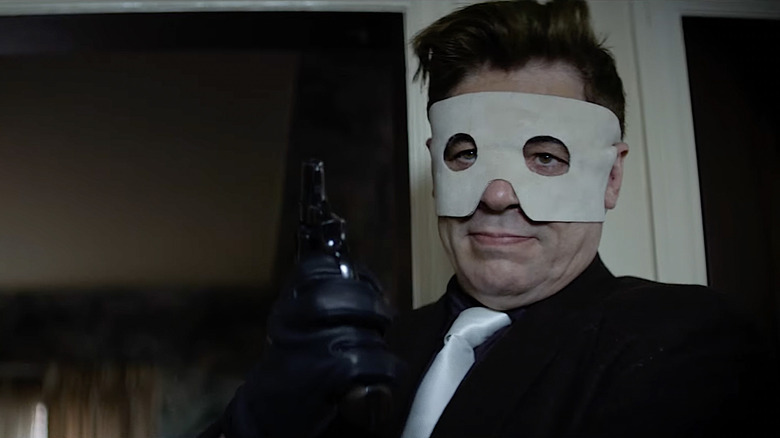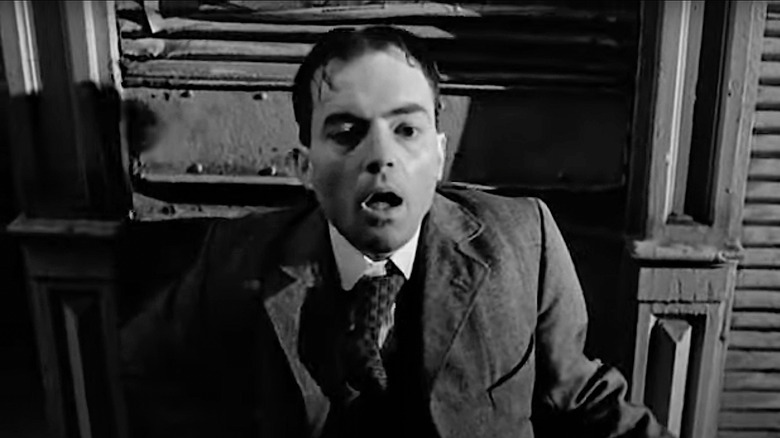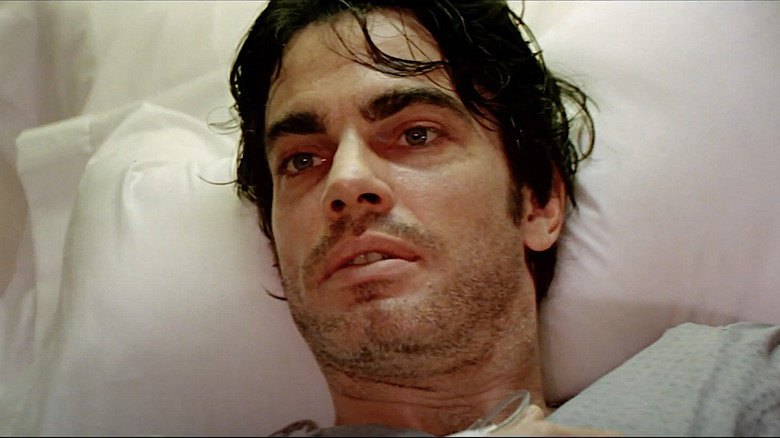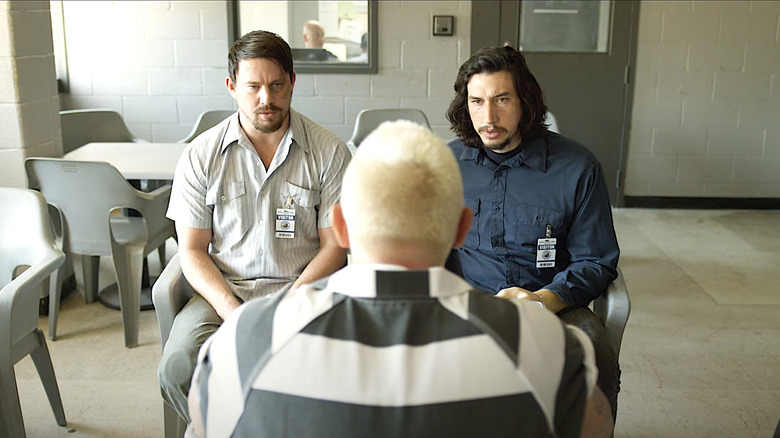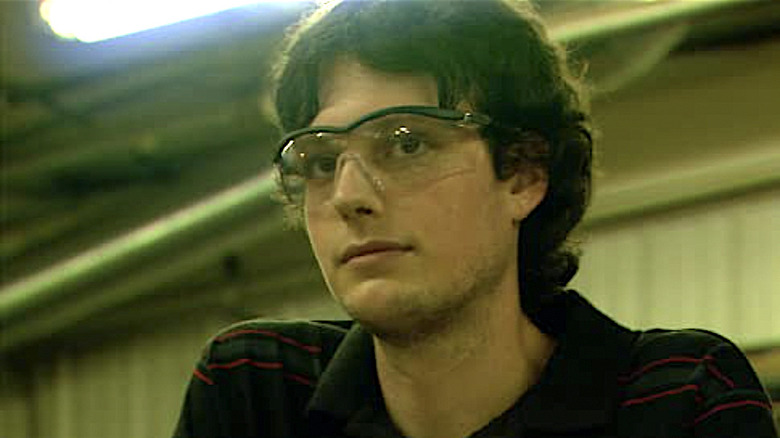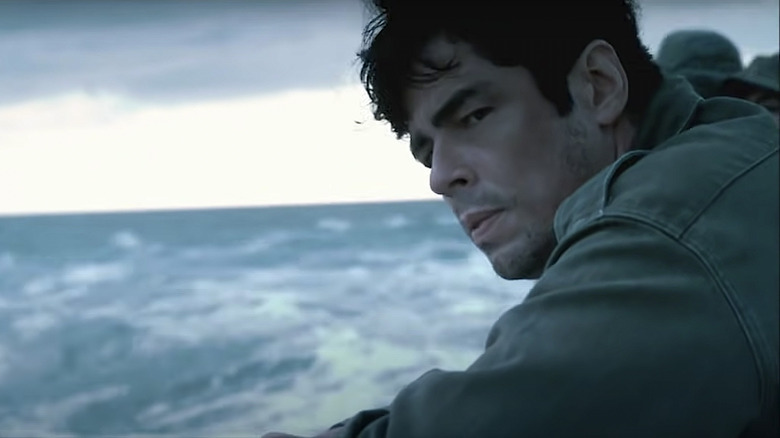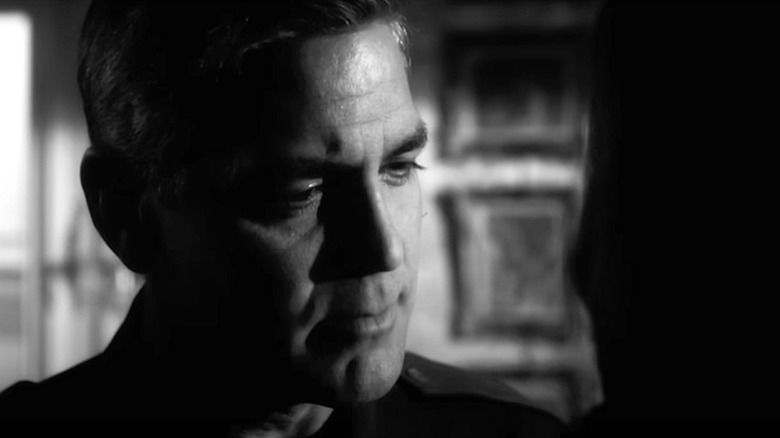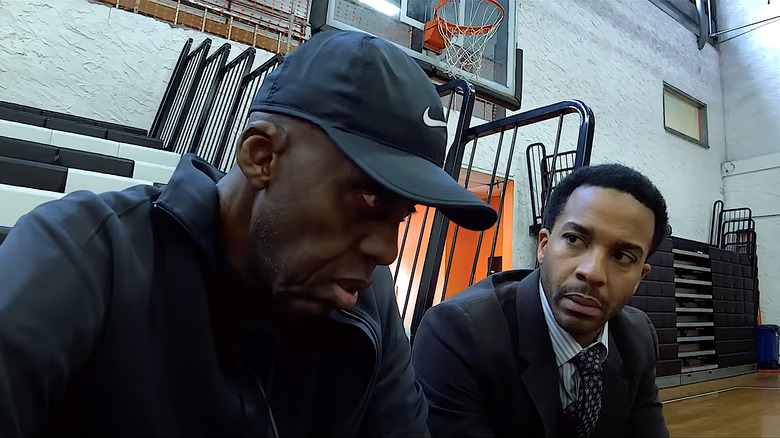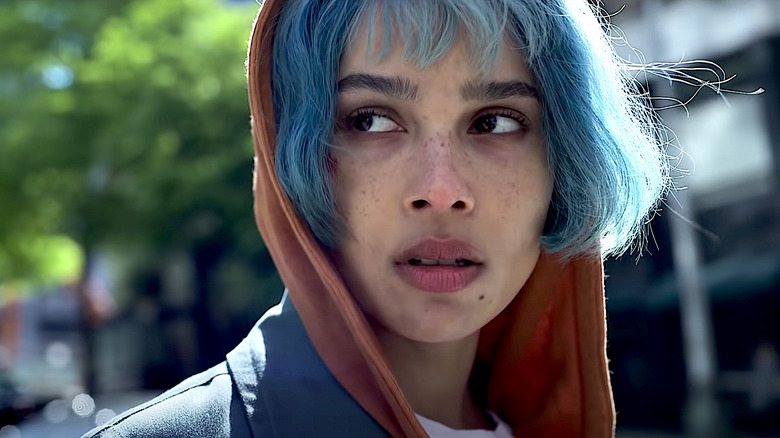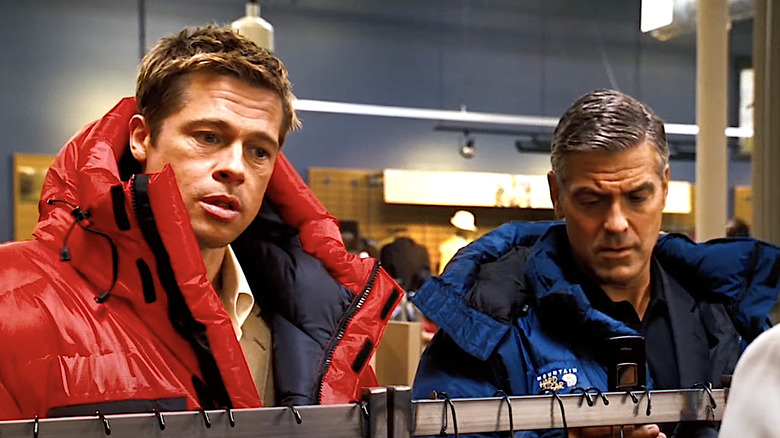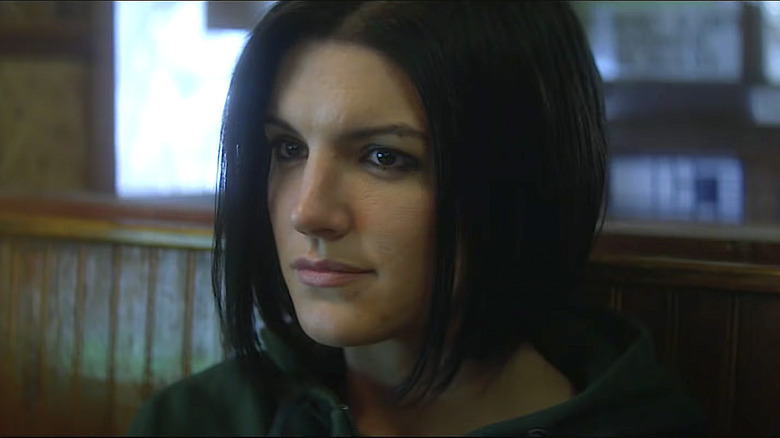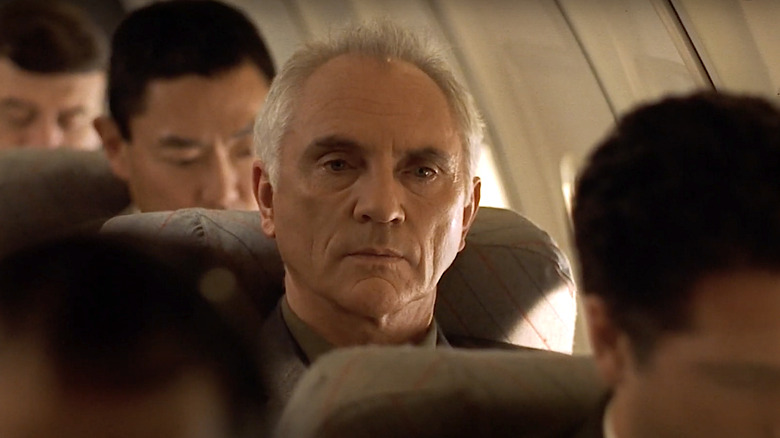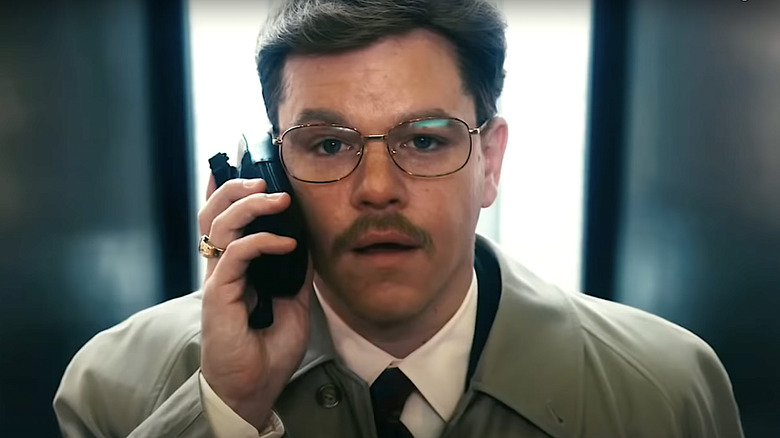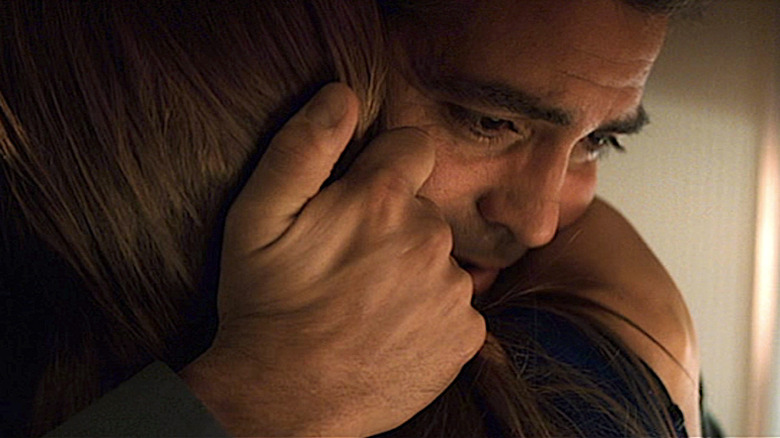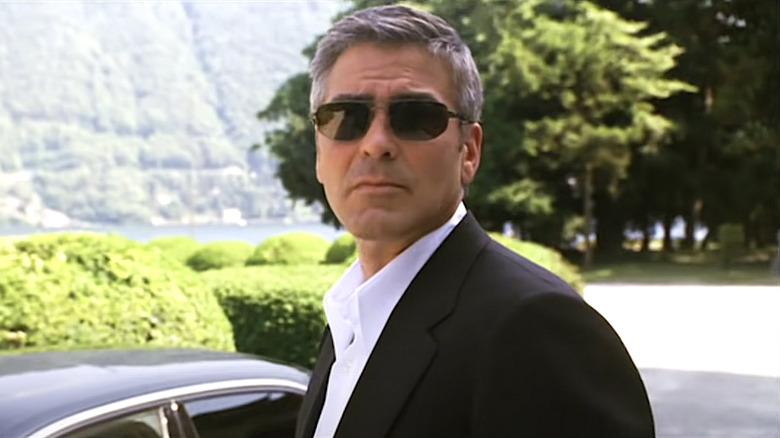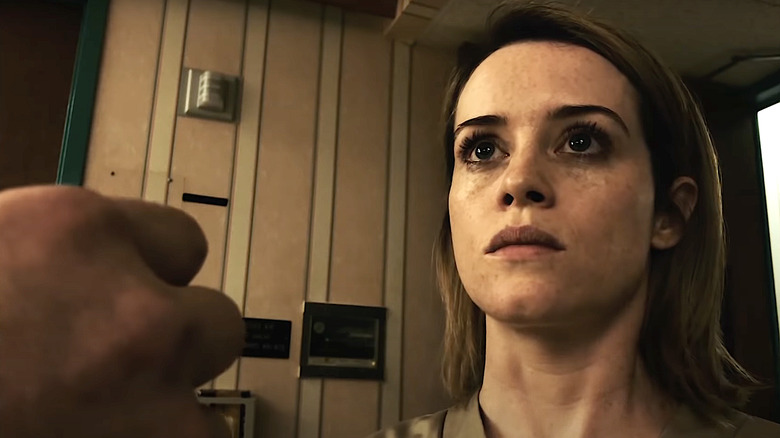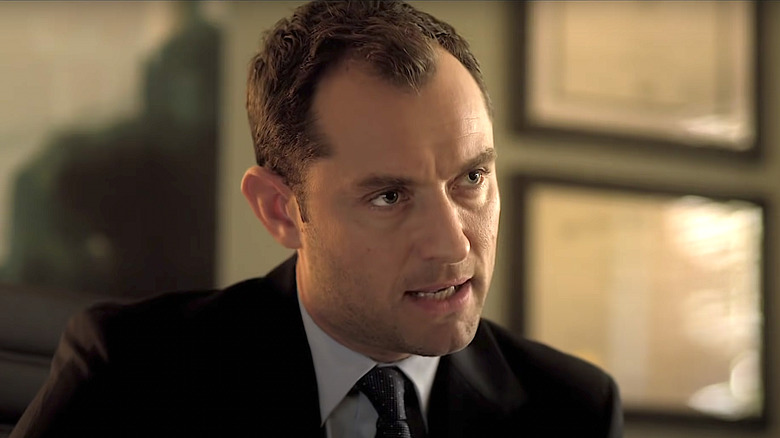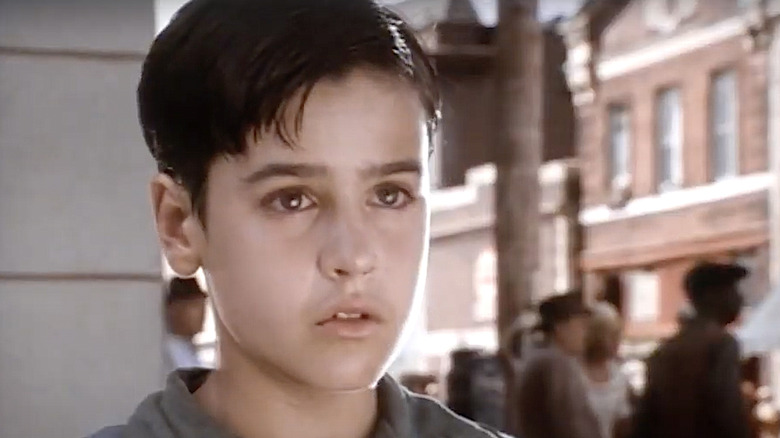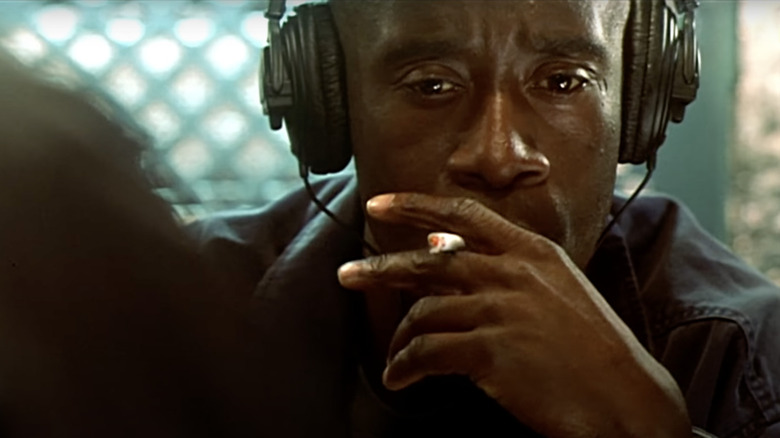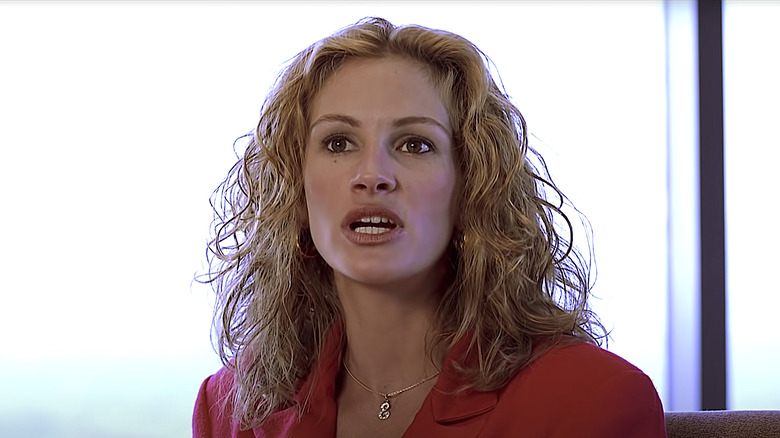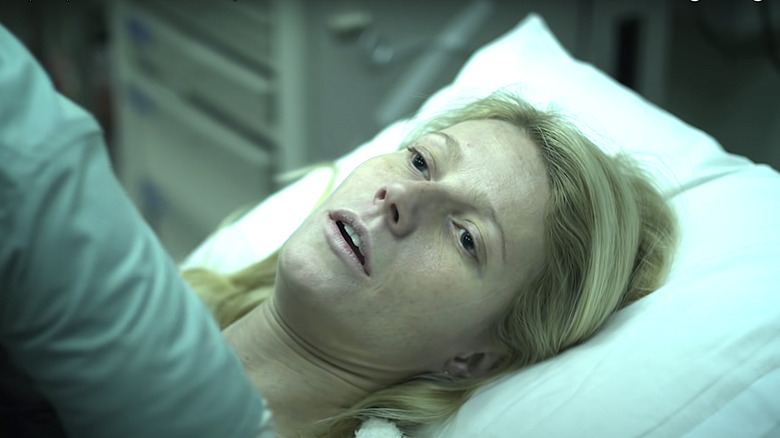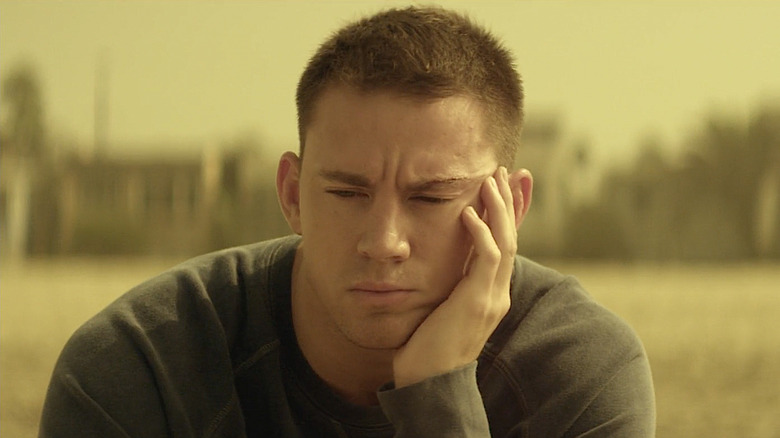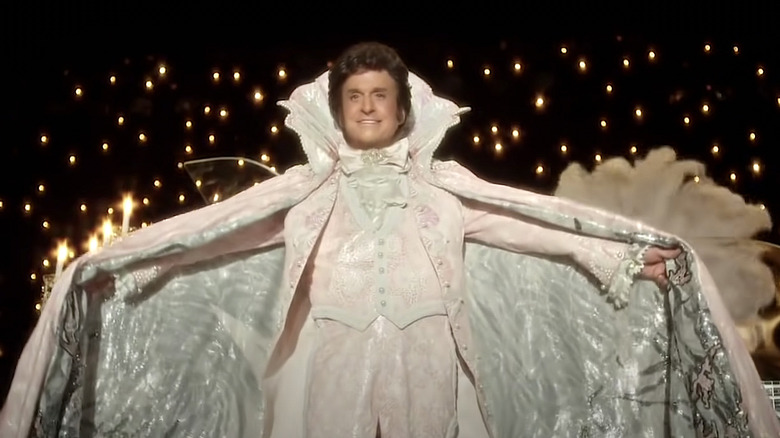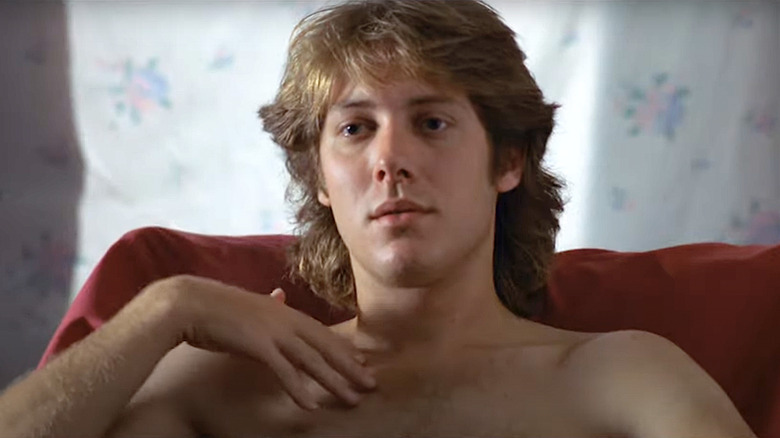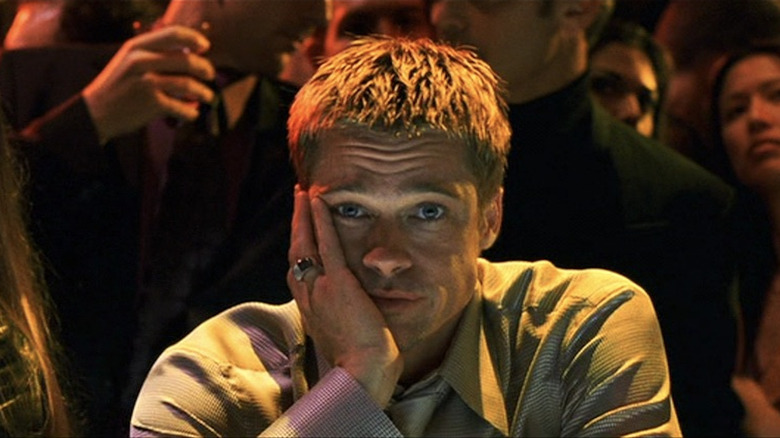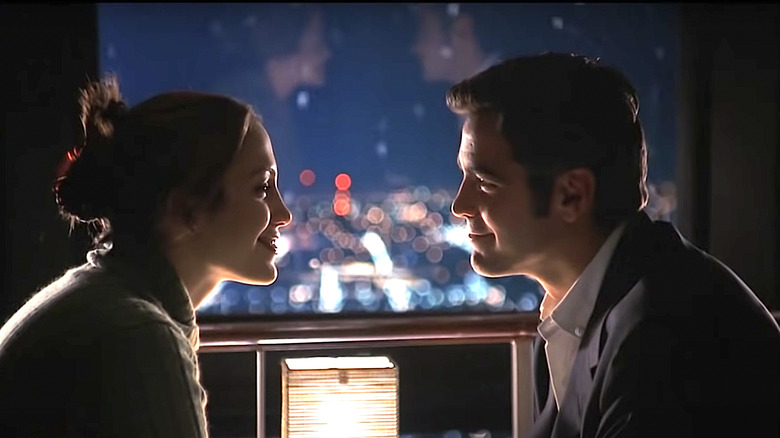Every Steven Soderbergh Movie Ranked Worst To Best
Spend a considerable amount of time with Steven Soderbergh's films, and it's impossible not to develop a fondness for this difficult man. He was just 26 when he burst onto the scene in 1989 with his breakout feature "Sex, Lies, and Videotape." The auteur's fetishistic fixations and raw filmmaking style created an immediate sensation, and earned him the coveted Palme d'Or at Cannes.
At that moment, Soderbergh could have done anything in Hollywood. Always the master of the unexpected, he went back to film school, at least in spirit, releasing a series of vexing low-budget cinematic experiments. Over the 30 years that followed, he's had numerous hits and won one Oscar. When he drops a project, you never know if it's going to be a popcorn crowd-pleaser or an art-house delicacy.
Soderbergh's drive to experiment has created a diverse filmography with wild peaks and valleys. When the iPhone's video camera approached minimal competency around 2016, the director began using it to shoot features. The films look awful, but three of them are actually good. Soderbergh doesn't much care about the aesthetic aspects of filmmaking. "As soon as I feel it, I want to shoot it," this run-and-gun master told IndieWire. His movies are about vibes and ideas, not craftsmanship, although his work is beautiful when he wants it to be. The end result is an uneven but insanely prolific career. However, when the director is at his best, you can only think that all that practice made perfect.
32. Full Frontal
2002's "Full Frontal" is one of Steven Soderbergh's many artistic dalliances with questionable results. Coming off the massive success of the Oscar-winning "Erin Brockovich" and the commercial juggernaut of "Ocean's Eleven," the director used his newfound clout to lure both Julia Roberts and, briefly, Brad Pitt, into one of the most wretched-looking films of his career.
This film about a day in the life of an ensemble of Hollywood types filming a movie-within-a-movie (as you'll see, meta cinema is a recurring theme on this list) isn't just a visually sloppy study of the form. It's actually an experiment. The cast had to follow specific rules: no trailers, bring your own food, provide your own wardrobe, and drive yourself to set. Rule 10? "Have fun," according to The New York Times.
Maybe the actors had a good time on set, but the viewing experience is anything but enjoyable. Good luck finding this film on any streaming service, too. "Full Frontal" has been effectively erased from history, and not without cause.
31. Schizopolis
If you want to understand Steven Soderbergh's eccentric mind, you need to reckon with "Schizopolis." By 1996, the director had received plenty of critical acclaim, directed an effective studio drama, and discovered his love of crime capers. With "Schizopolis," he took Martin Scorsese's famous "one for them, one for me" philosophy to an extreme. This one is definitely for him.
Soderbergh himself stars in this absurdist, surreal comedy, but is uncredited for any of his roles, because nothing here resembles conventional filmmaking. He's working in the Monty Python mode of deconstruction, but where those Brits broke down history and filmmaking tropes to amusing effect, "Schizopolis" is not likely to make you laugh. Funny comedy would be too predictable. Rather, "Schizopolis" is full of bizarre sketch-comedy tangents, which allow Soderbergh to explore his various intellectual hobby horses.
The real importance of the film is its looseness. It's an artistic throat-clearing that sowed the seeds for the blistering hot streak that Soderbergh would start two years later, beginning with "Out of Sight," moving on to "Erin Brockovich," and culminating with the Ocean's movies. As such, sitting through this self-indulgent detour isn't really necessary. The more audience-friendly films that follow speak for themselves.
30. Gray's Anatomy
In the early '90s, famous American actor and writer Spalding Gray was diagnosed with a "macular pucker," a disorder that robbed him of vision in his left eye. So, Gray did what he's most famous for and wrote a vivid, incredibly detailed monologue about his experience.
Steven Soderbergh is similarly fixated on the minutia of the (sometimes) mundane, and became obsessed with Gray's work in the late '80s. He gobbled up everything the actor wrote, and even cast him in 1993's "King of the Hill" just to observe his process, according to Criterion.
"Gray's Anatomy" is a quasi-documentary about Gray's obsession with his visual organs. It starts with a bunch of interviews from regular folks, who recount their own eyeball-related incidents. From there, it's basically Gray's stage monologue with some bells in the background. The eye-incident was "idiopathic," Gray notes — basically, it had no known cause. It was just the universe messing with the man, bringing mortality to the writer's agile mind. The film is not for everyone, but if you're a fan of Gray, who died under strange circumstances in 2004, it's the best document of the writer's loquacious style.
29. The Girlfriend Experience
In 2009, reigning Adult Video News performer of the year, Sasha Grey, was having a crossover moment. The wide-eyed porn star's fresh face belied a fetish-heavy on-screen persona so extreme and downright violent that her films were more like masochistic performance art than pornography.
When she started getting mainstream press after Steven Soderbergh cast the non-actor as the lead in "The Girlfriend Experience," Grey was self-branding as a feminist intellectual with an eye for cinema, casually quoting Godard's famous line, "Every edit is a lie." Of her pain-oriented porn persona, she told Rolling Stone, "I am a pervert. If I am working out any issues through porn, it's anger at society for not being open about sex."
Titillating promos aside, "The Girlfriend Experience" is a mess. Even more than the director's collaboration with MMA fighter Gina Carano, Grey's lack of chops is ruinously distracting. She flatly simulates acting, just as her character simulates companionship for money as a high-end escort. Maybe it's a meta-commentary on sex work, appealing to Grey's politics in 2009. Soderbergh's movies, though, are so improvisational and loose that he needs competent onscreen collaborators to turn his experiments into art. Unfortunately, Grey doesn't quite fit the bill.
28. Let Them Talk
In "Let Them Talk," Meryl Streep stars as an acclaimed writer who's having trouble finishing her latest novel. She's afraid to fly, and so takes a trans-Atlantic cruise to a conference where she's set to be honored with yet another prize. Onboard, she reconnects with two old friends and gets a chance to reckon with what's missing from her life of the mind.
This is another cinematic experiment for Soderbergh. It was filmed over a two-week period for HBO Max during a real trans-Atlantic trip. Soderbergh is working light with a compact but high-quality RED camera and minimal lighting. The script is a mere blueprint, notes Variety. Ironically, considering that this is a story about a writer, that means that most of the dialogue is improvised. The result is much the same as Soderbergh's other experimental works. It's a film that was no doubt interesting to work on, but is less so to watch.
27. The Laundromat
In "The Laundromat," a Netflix original, Meryl Streep plays a recent widower who lost her husband in a somewhat amusing boat accident. The sightseeing outfit actually has insurance for the 21 souls who drowned, but the underwriter turns out to be little more than a P.O. box in South America.
The film is narrated by Antonio Banderas and Gary Oldman, who are doing the "The Big Short" thing, breaking the fourth wall to teach us about the basics of money laundering. Their characters run an offshore operation that creates ready-made shell companies for crooks all over the world. They're kind of like the medieval Vatican of modern financial chicanery, selling indulgences to a tax-free heaven.
From there, the film sprawls into vignettes about the various clients of this offshore "laundromat." There's a Los Angeles-based lothario who sets up fraudulent trusts to finance his affairs, a Mexican cartel, and a murderous grifter who steals from the Chinese Communist Party. Soderbergh is hammering home the importance of the Panama Papers story by revealing the global scale of corruption they uncovered. However, the result is a glib film that lacks focus and any semblance of an emotional punch, its charms concealed by an opaque and complex crime story that probably deserves a bit more clarity.
26. No Sudden Move
It's easy to have high hopes when Steven Soderbergh drops a narrative film that's shot on cinema cameras and features professional actors and an actual plot. "No Sudden Move" is the prolific director's 2021 release for HBO Max. It's a twisty crime noir, but it has none of the smirky playfulness of his other caper films, and it's not any better for taking the subject so seriously.
Don Cheadle and Benicio Del Toro play two small-time trigger-men with mob ties in 1950s Detroit. The duo is tapped for a stickup job, but soon realizes that they've been double-crossed. They must uncover why before it's too late.
"No Sudden Move" tackles themes like race, corruption, and the intersection of organized crime and the American auto industry during the Motor City's post-war boom. Critics liked it, but audiences were less thrilled. This neo-noir takes cues from genre classics in the worst way: It's intensely talky, and not at all visual. The pace is also excruciatingly slow, as the director utterly abandons the punchy editing style of his best films. The result is a Soderbergh crime drama with none of his usual sizzle, and another entry in what is starting to feel like a late-career slump.
25. Kafka
Coming off the stunning success of "Sex, Lies, and Videotape," Steven Soderbergh was a hot commodity in Hollywood, but was also clearly determined to do something very different for his sophomore effort. Enter 1993's "Kafka." In it, Jeremy Irons plays a fictionalized version of famed novelist Franz Kafka, who's investigating the disappearance of a friend. However, Lem Dobbs's elaborate screenplay turns out to be much ado about nothing. The labyrinthine world that Kafka discovers is trippy and curious, but the mystery has a deeply unsatisfying conclusion. Isn't that all very Kafkaesque? Are you bored yet? Just wait; you will be.
Kafka's stories are about the insanity of the modern world, the infinite vortex of illogic and confusion that occurs when systems and power banish all common sense. It's very heady stuff, and notoriously difficult to film, given how interior Kafka's works are. Soderbergh deserves kudos for cashing in his blank check on this niche experiment when could have done anything else — and, in all honesty, probably should have.
24. The Underneath
1995's "The Underneath" is when Steven Soderbergh first discovered the formula that would lead to his biggest successes: the niche remake. This filmmaker doesn't microwave recent hits still radiating their original success. Instead, he grabs forgotten properties with promising premises that under-delivered. "The Underneath" is also Soderbergh's first dive into the crime genre, which took him from indie darling to box office icon.
"The Underneath" stars Peter Gallagher, Soderbergh's proto-Clooney, as a divorcee who returns to his hometown to win back his wife. When he gets a job as a driver for an armored car company, this chronic gambler can't resist becoming an inside man.
The films that Soderbergh made in the wake of his successful indie debut are like the missteps of a great boxer who consciously tries to add new punches to his arsenal. In the short term, all that thinking under pressure sets them back, even if it ultimately creates a more rounded combatant. None of the movies made during Soderbergh's prime are possible without both his early arty trifles and his fledgling attempts to flesh out his unique style.
23. Logan Lucky
"Logan Lucky" is like "Oceans 11" goes south. You'd think that Steven Soderbergh's Georgia roots and Louisiana education would give him a knack for creating characters who speak with a rural twang, but that's not the case in this campy clunker.
Channing Tatum and Adam Driver star as blue-collar brothers languishing in a West Virginia town full of the kind of Americans who fight our wars and dig our trenches, but who never really get a piece of the pie. Tatum is a slightly rotund laborer with a bum knee. Driver is a bartending war vet who lost his arm in combat.
To even the playing field, the duo begins to plan a heist, and enlists a rag-tag crew of kin and frenemies to help out. This includes an explosives expert played by Daniel Craig, who's doing a less effective version of his comically exaggerated "Knives Out" drawl. They want to rob a NASCAR event, because, did we mention, these people have Southern accents? From there, Soderbergh sets the scheme in motion. Just like in "Ocean's Eleven" the goofy mechanics of this implausible plot are the point. You'll have to wait until the end to find out their actual plan, but honestly? Don't bother.
22. Bubble
2005's "Bubble" is another Steven Soderbergh experiment shot on cheap-looking HD video, but this one sort of works, in part because his preferred lo-fi aesthetic actually matches up with his subject matter.
"Bubble" follows three struggling doll factory workers in Ohio, one of whom is murdered. However, don't mistake this human drama for a mystery. The cast is made up entirely of nonprofessional actors, and the script is largely improvised. Soderbergh edited the film himself, and is working as DP under his pseudonym, Peter Andrews, so blame that guy for the purposely drab look of this picture.
The strength of "Bubble" is what some critics hated about it: It doesn't glamorize poverty or the struggle of ordinary Americans. Factory workers are not more or less virtuous than anyone else. Instead, there's a lot of relatable humanity in this little film, if you can get past the fact that it doesn't look like movies by famous directors are supposed to look.
21. Che: Part 1 and Part 2
When Fidel Castro died in 2016 at age 90, the communist dictator who'd kept Cuba in poverty since the 1950s was worth $900 million, according to Forbes. The "brains" — and the muscle — behind the rise of the world's longest-lived hypocrite was an Argentinian physician turned guerilla warrior, Ernesto "Che" Guevara.
Today, Che is better known as a t-shirt, his handsome face adorning the chests of young lads seeking a masculine counter-culture icon. This Che is more meme than man, and yet Steven Soderbergh's ambitious four-and-a-half-hour, two-part "Che" attempts to create a beat-for-beat recap of his rise as a revolutionary in Cuba, and his downfall when he tried these same tricks in Bolivia.
As Guevara, Benicio del Toro is faultless in the failure of this endless, excruciatingly episodic epic. Che's fight for Cuba is intercut with his famous speech to the U.N. in 1964. That's the Che you know: green military attire, an unkempt beard, and a face obscured by cigar smoke. New York's intelligentsia swooned for the man's charismatic fervor — a rugged yet erudite warrior for the people, some supposed. "Che" is just a hagiography that animates this myth. It's also an unfeeling military procedural that offers no account for the fact that, to this day, ordinary Cubans are still driving around the same cars that they were when Guevara and his lofty ideals landed on their shores.
20. The Good German
If you're a fan of awesome things like World War II movies, black and white cinematography, George Clooney, spy thrillers, and Steven Soderbergh, you probably wanted to love "The Good German" in 2006. The film was Soderbergh's attempt to recreate the aesthetic of a classic Hollywood studio film, but with a plot unrestricted by the Hays Code's limitations. He even uses lenses of the era, according to The New York Times, and faithfully films in a boxy 4:3 aspect ratio that modern audiences will best recognize from "vintage" Instagram filters.
Clooney plays an American journalist in war-torn Germany who helps Cate Blanchett's character find her missing husband. However, Cold War intrigue is afoot, and nothing will ever be as straightforward as the head-on clash that just concluded.
"The Good German" is an ode to films of the past, but Soderbergh is too distracted with arty ambitions to tell a satisfying story. The result is a mess of moral relativism. Skip this art school dud and re-watch "Casablanca" instead.
19. High Flying Bird
"High Flying Bird" is a fictionalized account of the 2011 NBA lockout. It follows sports agent Ray Burke, played by the outstanding André Holland, who is similarly mesmerizing in Steven Soderbergh's wildly underrated series "The Knick." Burke is feeling the squeeze of the work stoppage. His marquee client is a number one draft pick who just inked a rich deal — in theory. In practice, the financial naivety of this young savant makes it hard to hold the line in this often-engrossing boardroom drama.
This is another horrendous-looking film from Soderbergh — his second shot on an iPhone, IndieWire notes. Soderbergh's choice of hardware was meant to streamline the shoot, but the limitations of the device ironically cost the production endless hours of tinkering in post-production. Soderbergh expresses disinterest in cinematographic craft and seems bemused by his friend David Fincher's exacting attention to visual detail, but it's odd to make a story about money look this cheap. Maybe Fincher will direct a basketball film. That would probably look incredible.
18. Kimi
"Kimi" is Steven Soderbergh's first Gen-Z-styled thriller and an ode to the isolation and paranoia of the post-COVID world. In it, Zoë Kravitz plays a blue-haired tech worker whose obsessive-compulsive disorder has been triggered by COVID protocols. This tortured shut-in's work-from-home gig for an Amazon Alexa-style bot company isn't helping things, either. Her whole job involves deciphering miscues between the humans she's afraid of and the ghost in the machine. But when she comes across a recording of what she thinks is a crime, surveillance capitalism wraps its tentacles around her.
"Kimi" ironically observes that our modern paranoias are both incredibly disordered and also totally justified. The early scenes nod to the voyeurism of 1954's "Rear Window," but just enough to note how much worse our isolation has become thanks to online "connectivity." The movie has its problems, like that a low-skilled, remote freelancer can somehow live alone in a multi-million-dollar loft in one of Seattle's tony tech-bro meccas. However, the film's saving grace is Soderbergh's late-career sense of irony, which resembles Stanley Kubrick's work. Soderbergh has built his own genre of disjointed, low-budget dystopian satires that start as hot-button social commentaries ("Side Effects" and "Unsane") and end in a darkly comic pool of blood. If he ever makes one of these movies with more end-to-end synergy, it could really be something.
17. Ocean's Thirteen
"Ocean's 13" has the same energy as the third "The Hangover" movie. It's as if Steven Soderbergh and his cast of movie stars all decided, as a group, that there was simply too much money on the table to walk away — and besides, they love hanging out!
Hangout movies are a criminally underrated genre. The only thing they require of you is to enjoy spending time with the cast. This isn't actually a low bar, given that these films rely on intangibles like stardust and chemistry. On that score, "Ocean's Thirteen" is a success; it's not like George Clooney and Brad Pitt are suddenly unlikable.
The first two Ocean's films work on a delicate balance of light-hearted hijinks and genuinely ingenious plot points. These impossible capers simmer on a low-boil. But, here, we see that Soderbergh and crew have gone back to the vault one too many times. This grift has gotten old, and too convoluted. Even if you were first in line when this film premiered in 2007, rewatch the trailer and see if any of this rings a bell. Oh yeah, Al Pacino is in this? And wait, Ellen Barkin? Okay, sure. "Ocean's Thirteen" isn't terrible. It's just forgettable. Soderbergh simply created something so uniquely great that it's just not possible to repeat it for a third time.
16. Haywire
Turning non-actors into movie stars is one of Steven Soderbergh's favorite self-imposed obstacle courses. Maybe he saw Gina Carano fight in Showtime's defunct MMA promotions and was intrigued that a woman with this much screen presence could be a professional fighter, let alone one with an aggressive striking style who pounded opponents until they crumpled to the canvas. After all, in victory, Carano always turned to the camera and flashed that megawatt smile.
In "Haywire," Soderbergh works around Carano's inexperience, casting her as a laconic black-ops badass who's off the reservation to right some wrongs. Notably, this minor attraction is the high mark of Carano's acting career. Her stiffly-acted role in "The Mandalorian" might've gotten more attention, but she was quickly shuffled into the void after sharing some repugnant hot takes on Twitter.
"Haywire" is the antithesis of the action genre's often idiotic contempt for physics. You won't find anything like Charlize Theron somehow front-kicking an enormous stuntman through a table in "Atomic Blonde" here. Carano is a genuinely imposing figure, and Soderbergh, always paying closer attention to the actors than the scenery, does yeoman's work getting her to not awkwardly smirk whenever the camera gets close, a newbie tick no one bothered correcting during Carano's stint in the Star Wars universe.
15. The Limey
A note on Steven Soderbergh's visual style: He loves high contrast cinematography, to the point that his highlights are often totally blown. It's a tick that gives otherwise ordinary shots a glow that lets you know you've entered the Soderverse.
In the very first shot of 1999's "The Limey" Terence Stamp, playing a tough-as-nails cockney ex-con named Wilson, enters the frame with half of his face and white hair transformed into a torch via the overexposed lighting. The other side of his face is obscured in shadow. Have we met a hero or a villain?
Wilson has come to Los Angeles to investigate the suspicious death of his estranged daughter. When he finds out that she's connected to an aging Hollywood Hills record producer with ties to organized crime, played affably by Peter Fonda, hell hath no fury as an absentee father scorned. Soderbergh fleshes out the character with an interesting use of flashbacks, built from footage of a young Stamp from a 1967 film called "Poor Cow," according to The New York Times. This is a revenge film, but the director won't let this limey unleash a self-righteous vendetta without examining the faults of a father whose daughter ran into the arms of a dangerous man old enough to be her dad, too.
14. The Informant!
In "The Informant," Steven Soderbergh takes his love of process to the world of corporate corruption, while Matt Damon packed on a few pounds and grew a silly '90s business mustache to play the titular snitch. The film is based on a real case brought against conglomerate Archer Daniels Midland, which was fined $100 million for a shockingly bold plan to fix global prices on Lysine, according to the Washington Post.
Damon plays a corporate exec turned FBI mole who gets out over his skis as his long trail of lies snowballs. He's at once thrilled to be a spy, but also sees his career prospects blossoming at the same time. An amusing combination of greed, vanity, overconfidence, and genuine smarts makes him want it to have it both ways. He's the kind of guy who would see himself as the Danny Ocean of corporate malfeasance, but since this underrated film is tethered to real events, it's not going to end with him in Julia Roberts' arms.
13. Solaris
In "Solaris," Steven Soderbergh again pseudonymously works as his own cinematographer, Peter Andrews. This time, the director's alter ego ditches his signature shaky camera for steadier movements. The perfectly lit orange and teal contrasts set the mood of this futuristic psychological space drama so perfectly that you can almost imagine Soderbergh saying, "Yes, I can do the big-budget look, too — and I don't even need credit."
George Clooney plays even-tempered psychologist Chris Kelvin, who's tapped for a one-man mission to a space station orbiting the planet Solaris. He thinks that he's been sent to talk down some anxious astronauts. When he shows up, the remaining crew is speaking in riddles and suffering from interstellar cabin fever far worse than anyone imagined.
There's no granite-jawed man in Hollywood who looks more like a movie star than Clooney, and no one uses gorgeous George better than Soderbergh. Here, the actor ditches his glib screen persona; this film is actually about inner space. Clooney's Kelvin must explore his own tragic past and reevaluate materialist assumptions about life and death if he hopes to unravel the mystery of a haunted vessel lost in the infinitely odd cosmos. "Solaris" is a little static, and slightly overstuffed with stoner profundities. It's no "2001: A Space Odyssey," but it's invigorating to see Soderbergh working in such a deliberately different space.
12. Oceans Twelve
"Ocean's Twelve" is that rare sequel that's a classic worthy of the original. Steven Soderbergh seems to understand he's not going to top himself, so essentially says, "Screw it, let's just do it again — this time in Europe!" The plot, as you may recall, involves casino magnate Andy Garcia strong-arming Danny Ocean and crew to work for him. It's as good a reason as any to get the band back together.
"Ocean's Twelve" is first and foremost a hangout movie. The film's promotion was heavy on the usual anecdotes about what a good time the cast had together, but with this group, you get the sense they all mean it, and it shows on screen. Clooney is widely known as a practical joker, but Brad Pitt turned the tables on him behind the scenes, posting a memo around Clooney's adopted hometown of Lake Como that he was to be addressed only as Danny Ocean. The prank worked, and local Italian papers were soon dubbing Clooney "El Devo," as he told GQ.
The two really never came out of this irreverent Ocean's dynamic during the whole of the press tour. Even the finale of the film's trailer is just the boys having a laugh. Given Soderbergh's intuitive style of simply flipping on the camera when the mood is ready, it's no wonder he captured lightning in a bottle twice.
11. Unsane
Large portions of 2018's "Unsane" were shot on the iPhone 7 Plus, which debuted before Apple's camera was legitimately good. The rest is shot on the low-rent Panasonic GH5. That's the kind of prosumer camera a wedding videographer might be justifiably proud to own. But don't let the digital grain and horrendous colors put you off of one of Steven Soderbergh's best thrillers.
Claire Foy of "The Crown" fame plays a woman dealing with PTSD from a relentless stalker. When she seeks treatment, she's involuntarily committed. Suddenly, the ugly cinematography makes sense. Somehow, the overly true-to-life look of cheap digital cameras brings out the soulless fluorescent-lit sterility of hospitals. The film delves into a feminist-tinged critique of a for-profit healthcare system, where filling hospital beds is the end goal. It's also part of the "Shutter Island" asylum genre. Is Foy's character actually "unsane," or is this woman being gaslit all over again?
That's when "Unsane" really goes off its meds and dares to be great, entering near New French Extremity territory and leaving the message-movie placebo behind. In the end, Soderbergh was just messing with our heads in order to get to some violent, twisty, cathartic shock therapy.
10. Side Effects
"Better living through chemistry," Jude Law's dapper psychiatrist jokes as he cracks open a Red Bull during a double shift at the ER. It's there that he meets Rooney Mara, fresh off a suicide attempt. Law prescribes trendy drugs for Mara's depression. Side effects may include sleepwalking, professional ruin, murder, and a twisty plot you won't see coming.
"Side Effects" came out in 2013, just as the public started waking up to the fact that some "wonder drugs" perhaps weren't the panacea that companies promised. Everyone in this film is on one pharmaceutical or another, from beta blockers to the fictional drug made up for the film, Ablixa.
Initially, Soderbergh is doing his procedural thing, with a plot about drug companies cajoling doctors into pushing their new pills; Law's character is bought off for a measly $50,000. The director, again acting as his own DP, fills the highlights with a hazy glow, as if it's all a dream. Meanwhile, the corrupt doctor is enveloped in a surprising nightmare. Like "Unsane," Soderbergh feints at a message movie, but takes a hard turn into an implausible yet highly watchable thriller, which makes the medicine go down much that easier.
9. King of the Hill
1993's "King of the Hill" is adapted from A. E. Hotchner's Depression-era memoir of the same name. With echoes of "A Bronx Tale" and the early scenes of "Goodfellas" (minus the gangster elements), this coming-of-age urban drama is a massive departure for Steven Soderbergh.
Jessie Bradford plays a motherless 12-year-old kid known as Aaron who must fend for himself inside a dilapidated hotel while his father is away on business. He's an artful little dodger, and uses his savvy and imagination to make the best of an otherwise terrifying situation.
"What I like in films about children is [that] the conflicts feel bigger," Soderbergh told Criterion. "It's ... more intense to see a child go through something they're probably not equipped to handle yet." It's fascinating to see the director switch gears from being an arty iconoclast to creating a film that's more along the lines of something that Steven Spielberg might do. It's territory that he's never really revisited, and the film is a must-see to appreciate Soderbergh's range. He really could make any kind of movie, and this conventional film proves it more than any of his more experimental oddities.
8. Traffic
"Traffic" felt revolutionary in 2000. Steven Soderbergh again weaves multiple storylines together to paint a broad picture of the drug war, as well as the hypocrisy that he thinks keeps the conflict at a devastating stalemate.
The film swept the Oscars in 2001, rewarding Soderbergh's direction, the screenplay, and the editing, all of which come together to follow the drug trade from Mexico, where cartel-driven corruption runs rampant, to the suburban dream home of an American drug tsar (Michael Douglas) whose own daughter is plagued by addiction.
This interlocking story structure probably peaked in 2004 with the wildly overwrought "Crash," which also made a splash at the Academy Awards. Another thing that dates the film is the color grading. Dusty Mexico is lit with a grainy yellow tungsten, while the American scenes shift into Michael Mann-style blue hues. Hollywood films have since adopted more subtle color standards, and are better for it. The film's politics are still relevant and the story is effective, so "Traffic" remains worth a look, but it's somewhat marred by stylish gimmicks that have since become weary cliches.
7. Erin Brockovich
"Erin Brockovich" is Steven Soderbergh's year 2000 turn as a studio hand, complete with Julia Roberts as his lead. He hands over the DP reins, and is even working from a script that he didn't write, seamlessly steering this $50 million film. The result is a smash hit that earned Roberts her only Oscar and got Soderbergh a nod for best director. 10 years after bursting onto the scene as an indie darling, Soderbergh was the king of L.A.
Roberts stars in this true story as the titular Brockovich, a struggling, silver-tongued single mom with a feverish temper who never met a push-up bra she didn't like. Brockovich's wardrobe belies her dogged smarts. When she finally finds work as a paralegal and pursues litigation for families poisoned by a chemical plant, her disagreeableness suddenly makes her an ideal legal eagle, complete with claws.
Deep into this heartfelt investigative procedural, one of Erin's cancer-riddled clients asks her, "If I have my uterus and breasts removed, am I still technically a woman?" That's largely what this film is about. Brockovich loves her children, yet she loves the thrill of chasing corporate evil-doers more. As the new man at home, played by Aaron Eckhart, grows weary of her long hours away, the film investigates the feminine dilemma of trying to have it all. Erin knows that she can't, but she has too much grit to give up on anything.
6. Contagion
When COVID-19 gave us all zombie apocalypse vibes in 2020, two pandemic-related films started streaming in heavy rotation. One was 1995's "Outbreak," directed by big-budget mainstay Wolfgang Peterson. There, the trouble starts with an infectious monkey. Dustin Hoffman uses a bunch of movie science to instantly synthesize a vaccine, and the film disintegrates into adventure-film hijinks as a cartoonish U.S. military looks to do a little nuclear-level sanitation.
2011's "Contagion" is the second of those films, and much more sophisticated. A stellar cast that includes Matt Damon, Kate Winslet, Jude Law, and Gwyneth Paltrow tells a multi-perspective story that captures the frantic complexity of the real post-SARS-variant world. "Contagion" is actually interested in the mechanics of a pandemic, dutifully explaining key concepts like an R-naught, aka how virologists calculate a disease's ability to spread. Soderbergh has always worked with kinetic documentary-style energy, and that's perfect for this anxiety-inducing film, which now reads as downright prophetic.
5. Magic Mike
The pure beefcake quotient of Matthew McConaughey and Channing Tatum playing oiled-up exotic dancers in "Magic Mike" had audiences overlooking the economic themes of Steven Soderbergh's spirited dance drama. Tatum is perfectly cast as the eponymous Mike, a hustle-minded south-Florida handyman moonlighting as an exotic dance. The star's lithe frame, raw athleticism, and glitchy-yet graceful-style also helped spawn a supersized sequel with the most memorable and impressive dance sequence from a movie star in modern film.
Mike's certainly got the moves, but this night job is a grind too. It's also a cash-driven gig that can't help his credit score. But as long as his fledgling furniture business needs financing, there's only one way he knows how to work it, even if his love interest isn't too keen on this double life. Mike tries hard to put it together with a string of hard-scrabble day jobs, but at the end of the day, he's worth a lot more as meat.
4. Behind the Candelabra
Steven Soderbergh's 2013's Liberace biopic "Behind the Candelabra" applies a fly-on-the-wall point of view to both a surprisingly relatable love story gone bad and a tale of celebrity decadence at its most disordered. The flamboyant virtuoso pianist was one of the biggest attractions in Las Vegas before he died of AIDs in 1987, but this was a different time, and Liberace's largely female fanbase is portrayed as hilariously oblivious to the homosexuality he's hiding in plain sight.
Soderbergh expertly delves behind Liberace's facelifts and starlet-shaped beards. Michael Douglas is utterly transformed as the sequined star, and Matt Damon is equally unrecognizable as Liberace's long-time houseboy, chauffeur, and lover. But this film is not some sob story about Liberace's tragic life. It's a study of excess. Douglas' Liberace is such a pathological, power-mad narcissist that he literally disfigures Damon in his own image (a hilariously taut-faced Rob Lowe as the film's resident plastic surgeon-slash-butcher does the gruesome honors). Liberace is just "The Tiger King," but with talent, and is similarly riveting in his ostentatious inhumanity.
3. Sex, Lies, and Videotape
"Sex, Lies, and Videotape" announced the arrival of a massive new talent in Tinseltown. Steven Soderbergh's brilliant debut, complete with an original screenplay, swept the festival circuit and vacuumed up tons of awards in 1989 and 1990. From the opening credits, the director's fluid dialogue floats over multiple expository vignettes and immediately sets the mood for this taut psychological drama about late 20th-century bourgeois boredom, kink, passion, and betrayal.
A radiant Andie MacDowell plays a neurotic and sexually stifled housewife, anxious about every issue of global sustainability yet oblivious to the power-suit-wearing adulterer in her own bed. That's when an eccentric with a camcorder fetish, played by a young James Spader in his breakout role, drifts into town and awakens her stunted desires.
If you missed this late '80s flick, don't dismiss it as yuppie supper theatre for white-collar boomers. It's smart, but it also feels like a personal film for Soderbergh, given that this is his first screenplay and that it happens to be about a mysterious filmmaker whose camera effortlessly undresses attractive women. Adding to the fantasy, the smooth-skulled director made sure to cast an unconventionally alluring leading man with a great shock of flowing locks. Young James Spader is a cult. Join immediately.
2. Ocean's Eleven
Steven Soderbergh is the remake king. "Traffic" is a remake. So is "Solaris," "The Underneath," and of course, "Ocean's Eleven," which harkens back to the Rat Pack-led original, which starred Frank Sinatra as the titular lead. But Soderbergh isn't remaking a classic. Sinatra's film is mediocre. As we've seen before, Soderbergh mines the past for hidden conceptual gems, and then makes them completely his own.
One overlooked aspect of Soderbergh's Ocean's films, particularly this genius first installment, is that there's no violence. This isn't mobbed-up Vegas of the '70s. It's the sanitized Vegas of 2001. This is a film for adults in temperament, but there's no blood, no profanity, and no sex. There's only the absolute apex of Soderbergh's obsession with process, this time expressed as the ingenious ins-and-outs of a plan to rob a modern casino vault and get past all that whiz-bang security.
It's still shocking to see what a difficult stunt Soderbergh is pulling off. Most filmmakers will acknowledge that comedy is the toughest genre, and here he stacks it on top of a high-wire heist plot. "Ocean's Eleven" is a triumph, and, in Soderbergh's hands, an undisputed classic.
1. Out of Sight
Steven Soderbergh is the master of the comedic crime romp. He's much less interested in the gorgeously filmed gravity of underworld goings-on than contemporaries like Michael Mann, director of "Heat," and his ilk. But "Out of Sight" is by far the best of Soderbergh's films about good-natured crooks who are both brilliant and bumbling. That's because it's also a visual treat that takes its story seriously enough to pull you in.
Much like Guy Richie's early work, Soderbergh gravitates towards material where his protagonists' mistakes his propel the plot forward. He even edits around the bloodshed performed by his baddies, keeping a tongue in the cheek of even the most violent psychopaths.
This blend of comedy and caper is delicate. Even with a smirking George Clooney playing a knowing con, "Out of Sight" never veers into the absurd. What anchors the action in this Elmore Leonard adaptation is the undeniable sizzle between Clooney's crook and the federal marshal played by Jennifer Lopez. Don Cheadle also gives one his best performances as a ruthless but chatty villain who intimidates more hapless delinquents with a murderously effective Socratic method. All Soderbergh's ticks are present: the monochromatic color schemes, the nonlinear editing, and the ironic '70s porno score. And yet, "Out of Sight" never devolves into the self-conscious goofiness that would undermine the other best thing about this slick little masterpiece: It's just so cool.
